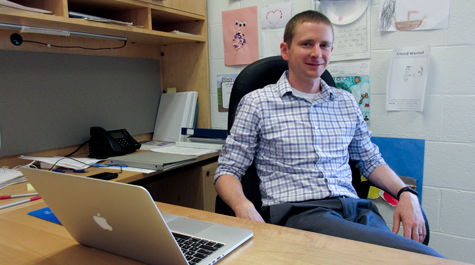Early Career Award allows physicist to probe mysteries of QCD and strange mesons
“Strange mesons” don’t get their name because they are more unusual or bizarre than any other meson, but rather because they contain a strange quark.
Justin Stevens explains that “strange” is one of the six types — or flavors — of quarks, fundamental particles that are involved in the construction of all matter.
Stevens, an assistant professor in William & Mary’s Department of Physics, received an Early Career Award from the U.S. Department of Energy’s Office of Science. His proposal, entitled “Strange mesons and gluonic excitations,” will be carried out at the GlueX experiment at Jefferson Lab (JLab), where Stevens is a bridged faculty member.
“GlueX stands for gluonic excitations experiment,” he said. “Our interest is in understanding the strong nuclear force.”
The strong nuclear force binds quarks into protons and neutrons, the more familiar components of the atom. Stevens explained that the proton, for instance, is built of two up quarks and one down quark. The three are held together by the strong force with the help of another particle known as a gluon. The theory of how this all works is known as QCD or quantum chromodynamics.
Stevens is one of a number of scientists working on verifying QCD through the observation of mesons, short-lived particles that aren’t readily found in nature, but that are created in experiments at JLab’s electron-beam accelerator facility. Both protons and neutrons are assembled from three quarks, but mesons are created from a quark-antiquark pair.
“GlueX is particularly interested in a new kind of particle known as a hybrid meson,” he said. Stevens added that hybrid mesons are particles predicted by QCD, which are distinguished by an excited gluonic field that holds the quark-antiquark pair together. Hybrid mesons containing strange quarks are one of the predicted varieties of such particles, which his experiment is specifically designed to look for.
“Since the theory of quantum chromodynamics predicts the existence of hybrid mesons, the experimental observation of such particles would provide another critical validation of our understanding of the strong nuclear force,” he said.
Hybrid mesons are distinguished by their peculiar gluonic field. Stevens said that even a basic gluon is a weird little thing — a particle that behaves like a field. Excited gluons carry extra energy, which increases the mass of the meson. Mesons are unstable and decay (into other mesons) almost as soon as they’re created, which is how they’re detected in the GlueX experiment.
Observing the decay of strange mesons and other exotic particles can help physicists understand the construction of more-stable particles such as the neutron and proton. Stevens explained that the Department of Energy, which oversees the U.S. nuclear program, funds projects like GlueX to further basic understanding of matter through observational verification — or correction — of the elements of quantum chromodynamics.
The DOE announcement notes that Stevens’ award was one of only 59 awarded after peer review of some 700 proposals. The award is for five years and carries a funding total of $750,000.
The funding will allow Stevens to hire a postdoctoral researcher and begin work on a new meson detector at JLab. Two Ph.D. students in physics at William & Mary, Amy Schertz and Andrew Hurley, will work with him at Jefferson Lab.
The DOE Office of Science Early Career Research Program, now in its eighth year, aims to bolster the nation's scientific workforce by providing support to exceptional researchers during the crucial early career years, when many scientists do their most formative work. Skip to main content
Skip to main content

